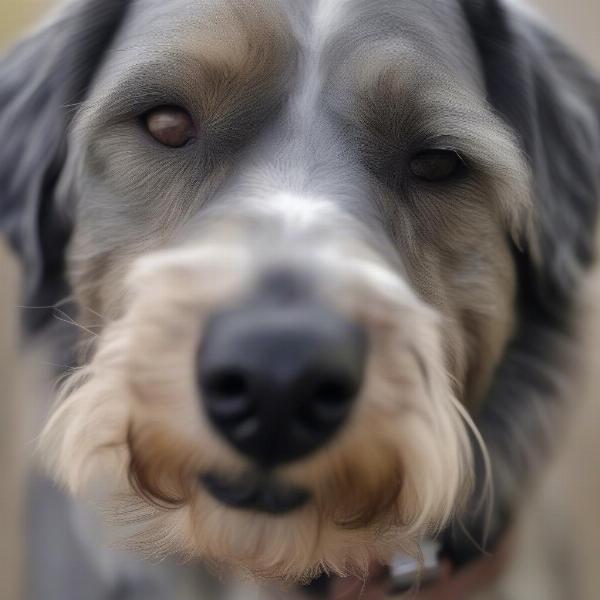Grey hair on dogs is a natural part of the aging process, much like in humans. While some dogs may start showing grey hairs earlier than others, it’s generally nothing to be concerned about. This article will delve into the reasons behind grey hair in dogs, when it’s typical to see it appear, and when it might be a sign of something more serious.
Why Do Dogs Get Grey Hairs?
Just like in humans, the appearance of grey hair in dogs is primarily due to a decrease in melanin production. Melanin is the pigment that gives hair its color. As dogs age, the cells that produce melanin, called melanocytes, become less active. This leads to new hair growing in with less pigment, resulting in grey or white hairs. Genetics also play a significant role. Some breeds are predisposed to greying earlier than others. For example, breeds like Labrador Retrievers and German Shepherds often show grey hairs around their muzzles as early as five years old.
Is Greying a Sign of Stress?
While anecdotal evidence suggests stress might contribute to premature greying in dogs, scientific studies have not definitively confirmed this link. grey hair dogs It’s more likely that genetics and the natural aging process are the primary drivers. However, chronic stress can negatively impact a dog’s overall health, so it’s essential to provide a calm and enriching environment for your furry friend.
When Should I Expect to See Grey Hair on My Dog?
Most dogs start showing grey hairs between five and seven years old. However, this can vary significantly based on breed, genetics, and individual factors. Some dogs may start greying as early as three years old, while others might not show any signs until they are much older.  A senior dog with a significantly greyed muzzle
A senior dog with a significantly greyed muzzle
Where Does Greying Typically Start?
Greying typically begins around the muzzle and then spreads to other areas of the face, chest, and legs. do dogs get grey hair Eventually, the entire coat may become predominantly grey or white.
When is Grey Hair a Cause for Concern?
While grey hair is usually a normal part of aging, it can sometimes be a sign of an underlying health issue, especially if it appears suddenly or in a young dog.
Health Conditions Linked to Premature Greying:
- Hypothyroidism: This condition affects hormone production and can cause various symptoms, including premature greying.
- Cushing’s Disease: An overproduction of cortisol can lead to a range of symptoms, including changes in coat color and texture.
- Nutritional Deficiencies: A lack of essential vitamins and minerals can sometimes affect coat health and pigmentation.
If you notice sudden or unusual greying in your dog, especially if accompanied by other symptoms like lethargy, weight changes, or skin problems, consult your veterinarian.
Caring for a Senior Dog with Grey Hair
Senior dogs often require extra care and attention. As their bodies age, they may become more susceptible to certain health problems. greyhound boxer mix dog Regular veterinary checkups are crucial for detecting and managing age-related health issues.
“Senior dogs often benefit from a diet tailored to their specific needs,” says Dr. Emily Carter, DVM, a leading veterinary specialist in geriatric canine care. “Supplements like omega-3 fatty acids can also help support joint health and maintain a healthy coat.”
Embracing the Silver Lining
Grey hair on your dog is a testament to the time you’ve shared together. It’s a symbol of the love, companionship, and countless memories you’ve created. fireplace dogs Embrace the silver lining and cherish every moment with your furry companion.
Conclusion
Grey hair in dogs is typically a natural sign of aging, influenced by genetics and reduced melanin production. While early greying might sometimes indicate an underlying health issue, it’s often nothing to worry about. sable color dog Regular veterinary checkups and a healthy lifestyle can help ensure your dog enjoys a happy and comfortable senior life, regardless of their coat color.
FAQ
- When do dogs usually start getting grey hair? Most dogs start showing grey hairs between five and seven years old.
- Is grey hair in dogs always a sign of old age? No, genetics can also influence the onset of greying, and some breeds grey earlier than others.
- Can stress cause grey hair in dogs? While the link between stress and greying isn’t scientifically proven, chronic stress can negatively impact overall health.
- Should I be worried if my young dog has grey hair? If your young dog shows sudden or unusual greying, consult a veterinarian to rule out any underlying health issues.
- How can I care for my senior dog with grey hair? Regular veterinary checkups, a balanced diet, and appropriate exercise are essential for senior dog care.
- What are the most common locations for grey hair to appear first in dogs? The muzzle is typically the first area to grey, followed by the face, chest, and legs.
- Are there any specific breeds that are more prone to early greying? Yes, breeds like Labrador Retrievers and German Shepherds often show grey hairs around their muzzles earlier than other breeds.
ILM Dog is a leading online resource for dog owners worldwide, providing expert advice on all aspects of dog care, from breed selection to senior care. We offer practical tips and insights on dog health, training, nutrition, grooming, and much more. Our mission is to empower dog owners with the knowledge and resources they need to provide their furry companions with the best possible care. For any questions or inquiries, please contact us at [email protected] or call us at +44 20-3965-8624. Visit ILM Dog for more information on how we can help you and your canine companion.